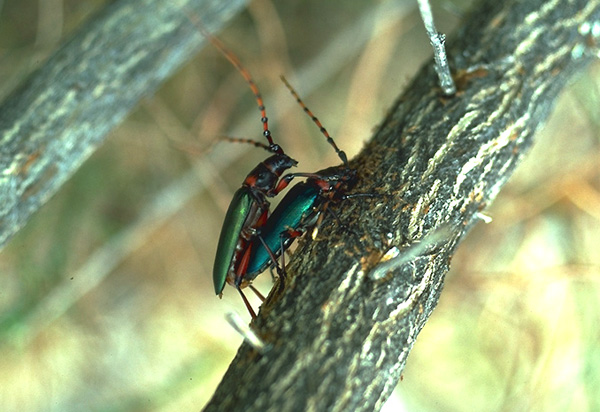Animal Behavior
at
Austin
College
Instructor:
Steven Goldsmith
Moody Science
114 or 320A; ext. 2342 or 2204; box 61611; sgoldsmith@austincollege.edu
Office Hours: M
9:00-10:00am and Th 1:30pm - 3:00pm
One of the most
surprising and fascinating aspects of biology is that animals behave,
which
is to say that they respond quickly to environmental stimuli in ways
that
tend to enhance their survival and reproduction. This ability is so
commonplace
that we humans (as animals that behave) do not usually consider the
incredibly
complex biochemical, physiological, neurological, and structural
machinery
that is necessary to accomplish behavior, nor do we consider the
adaptive
significance of behavior. One of my goals for this course is to impart
an appreciation for and fascination with animal behavior. We will
examine
the theoretical explanations for, and qualitative and quantitative data
that address animal behavior and its evolution. Students of behavior
recognize
that the abiotic, biotic, and social environments are the selective
forces
that have shaped the behavior of all animal species. We will practice
asking
questions about both mechanistic and evolutionary aspects of behavior,
and attempt to devise ways to answer our questions with qualitative
observations
or quantitative data. This course is also a lesson in field biology and
natural history, because the field is where many of our important
observations
are made in animal behavior, and because naturalists are "pre-adapted"
to be students of animal behavior.
There is no
textbook for this course. Instead, I will put copies of two or three
textbooks on reserve in Abell library. I will assign readings from the
primary or secondary scientific literature, from popular literature
(magazines, newspapers), and from sources of your own choosing (mostly
electronic). I will ask you to come to class prepared to report to the
class on what you have learned from your readings. Thus our class
sessions are a crucial source of information. In addition to formal
lecture material, much exchange of information will come from informal
discussion of specific topics during class meetings, and from
discussion of readings, videos, current events, and laboratory
experiences. It behooves you to be good primates and participate in
this type of communicative social interaction. Also, information about
upcoming lab exercises, and about data analyses and lab reports, will
be discussed during lecture sessions.
Links to
various salient features of the course:
Go to Steve
Goldsmith's home page
The course syllabus
(pdf)
Sample
exam questions (html)
Abell
Library's guide to evaluating sources
Darwin's Works
on-line
An interesting
article about statistics
in the NYT
Statistics
for novices (pdf)
Basics of vertebrate
neurobiology (pdf)
The "Waterboy" video clip
about the medulla oblongata (not "ablangata")
A neuoranatomy
tutorial (html)
The scotcharoos
recipe (pdf)
Gallup
et al, 2003 (article about human penis size and shape)
Seed-harvester
ant foraging lab report
WHO site on
FGM
All text and images
on this page copyright 2009, Steven Goldsmith
Last updated 29 October 2009
 |
The Cicada Killer wasp
with prey. This species (Sphecius
speciosus)
is a parasitoid. The mother wasp locates a cicada by listening
for
the cicada's call, then stings the host to paralyze it, places it into
a burrow, and lays an egg on it. The the egg hatches into a larva which
bores into the host and feeds on the internal organs of the host,
saving
the vital organs for last. After about a year, the larva emerges as an
adult wasp, and begins the cycle again. This photograph was taken in
July
2002, in Sherman, TX |
Advice on doing
field biology: Most of you probably
have
relatively
little experience in field biology. The labs in this course, in
addition
to their scientific content, will be an education in how to prepare for
and to behave in the field. Weather conditions September in Texas can
be
fairly unpleasant; you should take plenty of water (at least 1 liter)
when
we go in the field. Pants rather than shorts will be appropriate attire
for most outdoor labs, as will a light-colored shirt (I prefer 100%
cotton
rather that synthetics, and one with pockets). Sturdy shoes or boots
are
the best protection for your feet. You may want work gloves for some of
the labs. A hat or other headgear is essential, as is sunscreen and
sunglasses
(with UV protection). A sunburn on your eyeballs is particularly
unpleasant.
I usually carry a set of personal articles including aspirin, lip balm,
allergy medication, and toilet paper. If you have any special needs
along
these lines, it is usually best to bring it rather than be out in the
field
without it. I will provide a first-aid kit for minor injuries; broken
legs
and other major injuries are forbidden!
I also carry
a variety of general-purpose field gear. A field
notebook,
a ballpoint pen (not felt-tip!) and a pencil, scissors, forceps of
various
sizes, a pocketknife, a tape measure, a handlens, and a compass live in
a dedicated field backpack and always go with me in the field. A
wristwatch
is also an essential item. In addition to these items, I take whatever
equipment is necessary for the planned field activity. I will provide
the
latter items as we come to them. You should plan to take at least a
notebook
and pen or pencil, hat, water, and sunglasses. It is not absolutely
necessary
to have a field bag, but it is often useful.
 |
Stenaspis verticalis
(Coleoptera: Cerambycidae), a
large and
colorful long-horned beetle of the Sonoran Desert of Arizona. The
female (on the right) is feeding at a site defended by the male (on the
left) who is copulating with the female. This type of mating
system
is called resource defense polygyny. This photograph was taken in July
1987, northeast of Phoenix, AZ.
|

